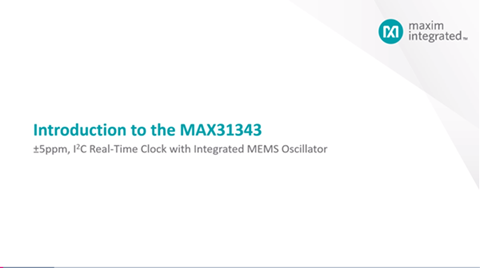MAX31343
RECOMMENDED FOR NEW DESIGNS±5ppm, I2C Real-Time Clock with Integrated MEMS Oscillator
Industry's Lowest Power MEMS-Based Temperature-Compensated RTC Reduces Crystal Mechanical Failure Susceptibility
- Part Models
- 4
- 1ku List Price
- Starting From $2.14
Overview
- Highly Accurate RTC with Integrated MEMS Resonator Completely Manages All Timekeeping Functions
- Complete Clock Calendar Functionality Including Seconds, Minutes, Hours, Day, Date, Month, Year, and Century with Leap-Year Compensation Up to Year 2199
- Timekeeping Accuracy ±5ppm (±0.432 second/day) from -40°C to 85°C
- Two Time-of-Day Alarms
- Temperature-Compensated Programmable Square-Wave Output
- Uncompensated Programmable Clock Outputs
- Automatically Switch over to Backup Battery or Supercapacitor on Power-Fail
- Digital Temperature Sensor with ±3°C Accuracy
- +1.6V to +5.5V Supply Voltage
- 64-Byte RAM for User Data Storage
- Simple Serial Interface Connects to Most Microcontrollers
- I2C Interface
- Battery-Backup Input for Continuous Timekeeping
- Low-Power Operation Extends Battery-Backup Runtime
- Operating Temperature Range: -40°C to 85°C
- 2.1mm x 2.3mm, 8-Pin WLP Package
- 4mm x 3mm, 8-Pin TDFN Package
- Underwriters Laboratories® (UL) Recognized
The MAX31343 is a low-cost, extremely accurate, I2C real-time clock (RTC). The device incorporates a battery input and maintains accurate timekeeping when main power to the device is interrupted. The integration of the microelectromechanical systems (MEMS) resonator enhances the long-term accuracy of the device and eliminates the external crystal requirement in the system. The MAX31343 is available in the 8-pin WLP and TDFN packages.
The RTC maintains seconds, minutes, hours, day, date, month, year, and century information. The date at the end of the month is automatically adjusted for months with fewer than 31 days, including corrections for leap year up to year 2199. The clock operates in the 24-hour format. Other features including two programmable time-of-day alarms, interrupt output, uncompensated programmable clock output, and temperature-compensated programmable square-wave output. Address and data are transferred serially through an I2C bidirectional bus. A voltage reference and comparator circuit monitors the status of VCC to detect power failures and automatically switch to the backup supply when necessary. See the Typical Application Circuit for more details.
Applications
- Action Cameras
- Communications
- Handheld Instrumentation
- Industrial
- Power Meters
- Wearables
Documentation
Data Sheet 1
Reliability Data 1
User Guide 2
Technical Articles 1
Video 1
Device Drivers 1
ADI has always placed the highest emphasis on delivering products that meet the maximum levels of quality and reliability. We achieve this by incorporating quality and reliability checks in every scope of product and process design, and in the manufacturing process as well. "Zero defects" for shipped products is always our goal. View our quality and reliability program and certifications for more information.
| Part Model | Pin/Package Drawing | Documentation | CAD Symbols, Footprints, and 3D Models |
|---|---|---|---|
| MAX31343EKA+ | COW | ||
| MAX31343EKA+T | COW | ||
| MAX31343ETAY+ | LFCSP | ||
| MAX31343ETAY+T | LFCSP |
This is the most up-to-date revision of the Data Sheet.
Software Resources
Device Drivers 1
Evaluation Software 0
Can't find the software or driver you need?









